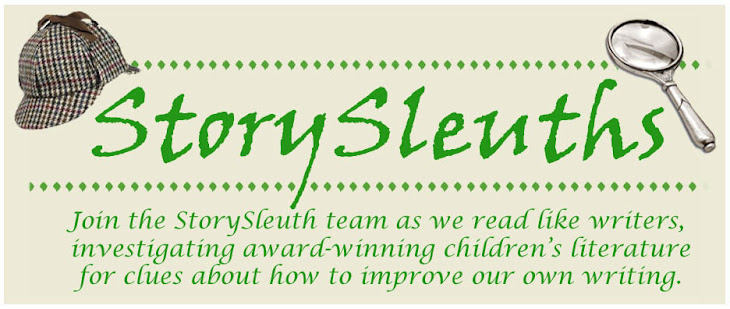Hi Meg-
I want to kick things off with this book by chatting a bit about chronology. There are so many ways to handle chronology in a story. The beginning, followed by the middle, followed by end works much of the time. Think "Red Riding Hood," or even A Wrinkle in Time, where there is a straight push from the beginning to the end without any diversions back in time. There may be mentions of the past, but no time is spent there. This is often the chronology recommended for younger readers who might find anything other than this straightforward method of storytelling confusing.
A story can be enhanced by mixing up the chronology. Consider the brilliant picture book The End, which starts with the final scene of the story and works its way backward, finally ending at the beginning. Or stories in which the ending is revealed, and then the author returns to the beginning and slowly works her way through the story as a means of revealing how that ending came to be. This can be a great tactic when writing somewhat scary books for younger kids—start with the ending to let them know that the character will survive, and then launch them into the protagonist’s perilous journey.
At the Western Washington SCBWI conference in May, 2009, literary agent Michael Stearns of Upstart Crow Literary suggested that mixing up the chronology can add interest to an otherwise saggy beginning. A great example is Judy Blundell’s novel What I Saw and How I Lied, which opens with a scene that is about two-thirds of the way through the story, then Blundell shifts to the beginning and tells the story in a straightforward way. The scene she chose to open with is a far more compelling hook than the actual beginning of the story would have been. It was a better place to start.
Chronology is a topic that fascinates me. In a Vermont College lecture on chronology, author Alison McGhee referred to chronology as a “slippery little fish,” and said, “If you change the chronology it changes everything about the piece.” In When You Reach Me, Rebecca Stead skillfully plays with chronology in a way that is perfect for this story of time travel, because the chronology mirrors the story itself—the chronology travels around in time. We start when Miranda has already figured out much of the mystery which is a key element to the book. We then travel with her back to the beginning, back to the present and so on until the entire story has been told. What makes the chronology successful rather than confusing is that Stead always grounds us wherever we are. Through the use of chapter headings, verb tense (more on those later) and sporadic references to the date, we always have clues about where we are in the story.
STORYSLEUTHS' TIP #21: Don’t be afraid to play with chronology as a means of enhancing your story.
-- Allyson
New! Go to next When You Reach Me Post
Coming Soon . . .

Touch Blue by Cynthia Lord
Upcoming Books
Followng the winter holidays we will look for clues about excellent writing in Cynthia Lord's latest, Touch Blue.
Hear about upcoming books and occasional writing challenges:
Story Sleuth Labels
- A Penguin Story (1)
- A Season of Gifts (5)
- Absolutely True Diary (14)
- Alchemy and Meggy Swann (8)
- All the World (1)
- Audience (1)
- Backstory (1)
- Blackbringer (6)
- Calpurnia Tate (4)
- Chapters (6)
- Characters (17)
- Charles and Emma (4)
- Description (1)
- Dialogue (1)
- Editors (3)
- Geektastic (9)
- Guest Post (13)
- Historical Fiction (6)
- Language (12)
- Literary Device (2)
- Marcelo in the Real World (9)
- Mirror Mirror (1)
- Mystery (1)
- Names (1)
- Narrative Hook (2)
- Newbery (2)
- Nonfiction (1)
- One Crazy Summer (8)
- Picture Books (1)
- Plot (2)
- Poetry (2)
- Point of View (5)
- Red Sings from Treetops (1)
- Research (1)
- Revision (5)
- Scene (4)
- Setting (6)
- Short Stories (5)
- Social Issues (4)
- Story Structure (16)
- subplots (1)
- Summary (1)
- Suspense (3)
- The Curious Garden (2)
- The Snow Day (2)
- Theme (8)
- TIPS (1)
- Title/Cover (1)
- Touch Blue (5)
- Turtle in Paradise (7)
- UBIQUITOUS: Celebrating Nature's Survivors (1)
- Voice (4)
- When You Reach Me (10)
- Where the Mountain Meets the Moon (7)
- Wisdom (3)
StorySleuth's Favorite Links
Followers
Search This Blog
Blog Archive
-
▼
2009
(36)
-
▼
November
(13)
- TITLE & COVER: When You Reach Me
- TENSE: When You Reach Me
- CHAPTER TITLES: When You Reach Me
- SECOND PERSON POV: When You Reach Me
- MYSTERY PLOTS & CLUES: When You Reach Me
- LARGER SOCIAL ISSUES: When You Reach Me
- MINOR CHARACTER SIGNIFICANCE: When You Reach Me
- SECONDARY CHARACTER ARC: When You Reach Me
- NARRATOR RELIABILITY: When You Reach Me
- CHRONOLOGY: When You Reach Me
- The Storysleuths Game Plan for When You Reach Me
- FIRST CHAPTER ADVICE: My Final Freshman Year Repor...
- IRONY, ONE WORD SENTENCES: Rowdy and I... & And Be...
-
▼
November
(13)
(c) 2009-2010 StorySleuths



